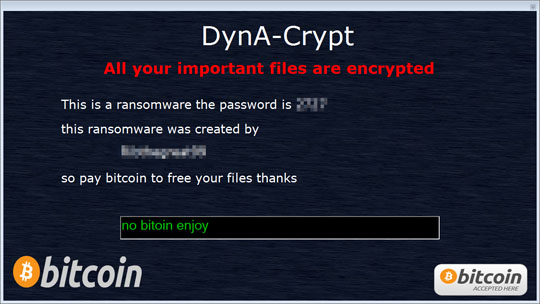RANSOM64_DYNACRYPT.A
HEUR:Trojan.Win32.Generic (KASPERSKY), W32/Generic.NHD!tr (FORTINET)
Windows


Threat Type: Ransomware
Destructiveness: No
Encrypted: No
In the wild: Yes
OVERVIEW
This Ransomware arrives on a system as a file dropped by other malware or as a file downloaded unknowingly by users when visiting malicious sites.
It executes the dropped file(s). As a result, malicious routines of the dropped files are exhibited on the affected system.
It steals sensitive information such as user names and passwords related to certain games.
TECHNICAL DETAILS
Arrival Details
This Ransomware arrives on a system as a file dropped by other malware or as a file downloaded unknowingly by users when visiting malicious sites.
Installation
This Ransomware drops the following file(s)/component(s):
- %All Users Profile%\helper.exe
- %All Users Profile%\rec.exe
- %All Users Profile%\cwin.exe <- detected as Ransom_Genasom.R047C0DBA17
- %ProgramData%\helper.exe
- %ProgramData%\rec.exe
- %ProgramData%\cwin.exe <- detected as Ransom_Genasom.R047C0DBA17
- %AppDataLocal%\dyna\cry.exe <- detected as Ransom_DYNACRYPT.THAOEH
- %AppDataLocal%\dyna\kl.exe <- detected as Ransom_Genasom.R002C0DD417
- %AppDataLocal%\dyna\st.exe <- Ransom_DYNACRYPT.THAOEH
- %AppDataLocal%\dyna\res
- %AppDataLocal%\dyna\loot\Keylog\keylog_{date & time}.log <- contains keylog strokes
(Note: %All Users Profile% is the All Users folder, where it usually is C:\Documents and Settings\All Users on Windows 2000, Windows Server 2003, and Windows XP (32- and 64-bit); C:\ProgramData on Windows Vista (32- and 64-bit), Windows 7 (32- and 64-bit), Windows 8 (32- and 64-bit), Windows 8.1 (32- and 64-bit), Windows Server 2008, and Windows Server 2012.. %ProgramData% is the Program Data folder, where it usually is C:\Program Files in Windows 2000, Windows Server 2003, and Windows XP (32- and 64-bit); C:\ProgramData in Windows Vista (32- and 64-bit), Windows 7 (32- and 64-bit), Windows 8 (32- and 64-bit), Windows 8.1 (32- and 64-bit), Windows Server 2008, and Windows Server 2012.. %AppDataLocal% is the Application Data folder found in Local Settings, where it is usually C:\Documents and Settings\{user name}\Local Settings\Application Data on Windows 2000, Windows Server 2003, and Windows XP (32- and 64-bit); C:\Users\{user name}\AppData\Local on Windows Vista (32- and 64-bit), Windows 7 (32- and 64-bit), Windows 8 (32- and 64-bit), Windows 8.1 (32- and 64-bit), Windows Server 2008, and Windows Server 2012.)
It creates the following folders:
- %AppDataLocal%\dyna
- %AppDataLocal%\dyna\loot
- %AppDataLocal%\dyna\loot\Keylog
(Note: %AppDataLocal% is the Application Data folder found in Local Settings, where it is usually C:\Documents and Settings\{user name}\Local Settings\Application Data on Windows 2000, Windows Server 2003, and Windows XP (32- and 64-bit); C:\Users\{user name}\AppData\Local on Windows Vista (32- and 64-bit), Windows 7 (32- and 64-bit), Windows 8 (32- and 64-bit), Windows 8.1 (32- and 64-bit), Windows Server 2008, and Windows Server 2012.)
Dropping Routine
This Ransomware executes the dropped file. As a result, malicious routines of the dropped file are exhibited on the affected system.
Information Theft
This Ransomware steals sensitive information such as user names and passwords related to the following games:
- Minecraft
- Steam
- TS3
It gathers the following data:
- Keylog strokes
- Screenshots
It attempts to steal stored email credentials from the following:
- Thunderbird
- Skype
It attempts to get stored information such as user names, passwords, and hostnames from the following browsers:
- Chrome
- Firefox
Stolen Information
This Ransomware saves the stolen information in the following file:
- %AppDataLocal%\dyna\loot\Chrome\Cookies
- %AppDataLocal%\dyna\loot\Chrome\History
- %AppDataLocal%\dyna\loot\Firefox\key3.db
- %AppDataLocal%\dyna\loot\Firefox\places.sqlite
- %AppDataLocal%\dyna\loot\Firefox\Keylog\keylog_{date & time}.log
- %AppDataLocal%\dyna\loot\Minecraft
- %AppDataLocal%\dyna\loot\Screenshots
- %AppDataLocal%\dyna\loot\Skype
- %AppDataLocal%\dyna\loot\Steam
- %AppDataLocal%\dyna\loot\Thunderbird
- %AppDataLocal%\dyna\loot\TS3
- %AppDataLocal%\dyna\loot\browserpass.txt
(Note: %AppDataLocal% is the Application Data folder found in Local Settings, where it is usually C:\Documents and Settings\{user name}\Local Settings\Application Data on Windows 2000, Windows Server 2003, and Windows XP (32- and 64-bit); C:\Users\{user name}\AppData\Local on Windows Vista (32- and 64-bit), Windows 7 (32- and 64-bit), Windows 8 (32- and 64-bit), Windows 8.1 (32- and 64-bit), Windows Server 2008, and Windows Server 2012.)
Other Details
This Ransomware does the following:
- It executes powershell commands:
powershell -win hidden -enc {encrypted string}
- It displays the following window as a ransom note:

- This ransomware is still in development, it is not capable of encrypting files.
SOLUTION
Step 1
Before doing any scans, Windows XP, Windows Vista, and Windows 7 users must disable System Restore to allow full scanning of their computers.
Step 2
Note that not all files, folders, and registry keys and entries are installed on your computer during this malware's/spyware's/grayware's execution. This may be due to incomplete installation or other operating system conditions. If you do not find the same files/folders/registry information, please proceed to the next step.
Step 3
Restart in Safe Mode
Step 4
Search and delete these folders
- %AppDataLocal%\dyna
Step 5
Search and delete these files
- %All Users Profile%\helper.exe
- %All Users Profile%\rec.exe
- %All Users Profile%\cwin.exe
- %ProgramData%\helper.exe
- %ProgramData%\rec.exe
- %ProgramData%\cwin.exe
Step 6
Restart in normal mode and scan your computer with your Trend Micro product for files detected as RANSOM64_DYNACRYPT.A. If the detected files have already been cleaned, deleted, or quarantined by your Trend Micro product, no further step is required. You may opt to simply delete the quarantined files. Please check this Knowledge Base page for more information.
Step 7
Restore encrypted files from backup.
Did this description help? Tell us how we did.


